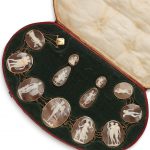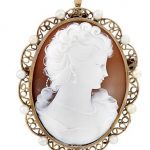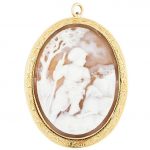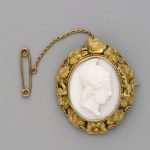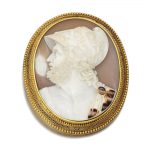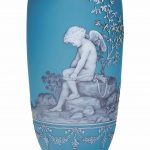Information on shell cameos. Although occasionally used in Roman cameos, the earliest prevalent use of shell for cameo carving was during the Renaissance, in the 15th and 16th centuries. Before that time, cameos were carved from hardstone. The Renaissance cameos are typically white on a grayish background and were carved from the shell of a mussel or cowry, the latter a tropical mollusk.
In the mid 18th century, explorations revealed new shell varieties. Helmet shells (Cassis tuberosa) from the West Indies, and queen conch shells (Eustrombus gigas) from the Bahamas and West Indies, arrived in Europe. This sparked a big increase in the number of cameos that were carved from shells. Conch shells carve very well, but their color fades over time.
After 1850 demand for cameos grew, as they became popular souvenirs of the Grand Tour among the middle class. Reference: Wikipedia
Shell cameos are much easier to cut than those made from gemstones. Also, the raw material is cheaper and easier to acquire. They were popular in the 16th century and then again in the 18th and 19th centuries, when the passion for carved gemstones led to a parallel explosion in the market for cheaper shell cameos. They are still popular today. Reference: Victoria & Albert Museum
A mid-nineteenth century shell cameo necklace and earclip suite Designed as a graduated series of oval shell cameos, depicting classical figures including Hermes, Minerva and Venus, the earrings each designed as a pear-shaped cameo, also depicting classical figures, mounted in gold, earrings converted from pendent earrings and accompanied by the original circular cameo surmounts, lengths: necklace 43.0cm, earclips 3.6cm, surmounts 1.8cm, fitted case (2)
Sold for £ 3,125 inc. premium at Bonhams in 2018
Set or parure of carved conch shell jewellery, comprising tiara (a), bracelet (b), necklace (c), brooch (d) and earrings (e-f), in the original dark red leather case (g) with blue silk lining to the lid and blue velvet for the base. Carved with marine motifs incorporating sea-horses, dolphins, mermaids and scallop shells. The larger elements are riveted to a gold wire frame, from which the smaller elements are suspended.
Technically, this is a tour de force: each piece in this set is made up of multiple elements, cut from thin sections to achieve an almost translucent effect and then riveted to a gold framework, invisible from the front. Much of the work is undercut or hollowed out with remarkable delicacy. The giant, or Queen, conch shell (Strombus gigas) was imported from the West Indies and occurs as distinct pink and white layers. Because the layers are relatively thin, and the strong colour occurs mainly on the lip of the shell, multiple pieces were often built up to create a high relief cameo effect. The parure is not marked, but there is no doubt that it was carved and mounted in Naples, the centre of the shell and coral carving industry. Shell work was widely exported to England. If not acquired on a visit to Italy, the parure may have been purchased from one of the importers of Neapolitan jewellery in London such as the Bond Street firm of Robert Phillips, who exhibited work from Naples at the London International Exhibition of 1862. The parure is included in a list of family heirlooms made by the vendor’s father in 1952 as belonging to Marie Caroline Queen of Naples ( ie. early 19th century, so this cannot be correct). See article in BM Magazine, June 2004.
Reference: © The Trustees of the British Museum
A SHELL CAMEO BRACELET, BY BUCCELLATI Composed of a series of rectangular shaped shell cameos, depicting various classical figures riding chariots, including Aurora and Apollo, 17.5cm Signed M. Buccellati
Sold for GBP 3,250 at Christies in 2016
Gold, Pearl and Shell Cameo Pendant-Brooch 14 kt., 11 pearls ap. 3.7 to 3.5 mm., ap. 11.3 dwts. Pearls have not been tested.
Pearls: round, off white color, good to very good luster Overall in good condition, normal wear withminor discoloration to metal. Measuring ap. 2 1/4 x 1 7/8 inches
Sold for $292 (includes buyer’s premium) at Doyle New York in 2018
One camero pendant/pin featuring: 14KT yellow gold weighing 21.6 grams containing one hand engraved shell cameo. The pin measures 2.25 inches x 1.75 inches.
Sold for $550 at BK Auctions in 2018
Badge of the Order of Saint Michael Date:17th century, with modern chains and links
Both sides of this pendant contain shell cameos with well-worn, almost mirror images of the archangel Michael putting down Satan. The badge belonged to a member of the French Royal Order of Saint Michael, which was founded by Louis XI in 1469. Badges with shell were reputedly presented to ecclesiastic members, whose numbers had swelled to one hundred before they were reduced to six by decree of Louis XIV in 1655 as part of a reform of the chivalric order.
Reference: The Metropolitan Museum of Art
Gold brooch set with an Italian shell cameo, shaded pale pink featuring a profile of Roman Centurion. The ornate gold frame features small figures of an emu and kangaroo flanking either side of the cameo centrepiece complimented by floral motifs, made in Australia about 1870. A small safety chain is attached to the top of the brooch with a fastening pin on the end.
This brooch is a fine example of the jewellery produced towards the end of the gold rushes in eastern Australia. Gold rushes continued in Australia into the 1870s although the finds were smaller and the level of excitement had begun to diminish. This combined with a gradual change in fashion led to the production of brooches and bracelets that were less massive and with a more restrained use of indigenous motifs than at the height of the gold rush in the 1850s and 1860s. Often the only hint at Australian origin would be found in the tiny kangaroos and emus incorporated into folate frames embracing an Italian cameo shell or micromosaic. The mainstream of locally made jewellery at this time concentrated on the use of local gemstones in designs that followed European fashions.
Reference: Brilliant, Australian Gold and Silver, 1851-1950, edited by Eva Czerniz-Ryl, Powerhouse Publishing, Sydney Australia, 2011
Museum Applied Arts and Sciences
Shell cameo pendant-brooch by Tomasso Saulini, mounted by Robert Phillips, 1860s The oval shell cameo carved to depicte the sinistral of Menelaus, signed T. Saulini F, within an open work border in the Etruscan Revival style, pendant and brooch fittings, maker’s mark for Robert Phillips.
Tomasso Saulini (1793-1864) was a gem carver based in Rome, renowned for the quality of his carved cameos in both hardstone and shell. Saulini began his studies in 1836 in Rome, under the tutelage of the Danish sculptor Bertel Thorwaldsen (1770-1844). Saulini found patronage among the aristocracy across Europe, and in 1860, moved to London to engrave portraits of Queen Victoria and Prince Albert. Several of his stone cameos were exhibited at the International Exhibition of 1862, and shell versions of the exhibited pieces were sold alongside them. It is possible that present piece may have been originally shown in this context. The present cameo takes its design from a statue of Menelaus supporting the body of his fallen comrade Patroclus from the Iliad, displayed alongside works by Cellini and Giambologna in the courtyard of the Palazzo Vecchio, Florence. A similar shell cameo depicting Minerva by Tomasso Saulini, similarly mounted by Robert Phillips and dating from circa 1860 can be found in the British Museum, museum no. 1978,1002.589.
Sold for 5,625 GBP at Sothebys in 2018
Cameo made of shell, depicting a laureated bust of the Roman emperor Vespasian. Made in Italy circa 1550-1580.
Copyright: © Victoria and Albert Museum
Shell cameo after William Henry Rinehart’s Sculpture “The Woman of Samaria”
This cameo is after William Henry Rinehart’s “Woman of Samaria,” a major life-size sculpture in marble commissioned by William T. Walters and completed in 1861. The Walters Art Museum owns two other cameos after Rinehart’s work (see Walters 57.2001 and Walters 57.854). One of these, a profile portrait of Ellen Walters, William’s wife, was a commission from the Roman workshop of Augusto Castellani (1829-1914). It is therefore possible that this cameo was commissioned from the same workshop at around the same time. Cameos done after sculptures were known in ancient times, and the practice continued in the 19th century. Castellani also executed a bust-length cameo of Hiram Powers famous statue the “Greek Slave,” exhibited in the Great Exhibition of 1851.
Reference: The Walter Art Museum
